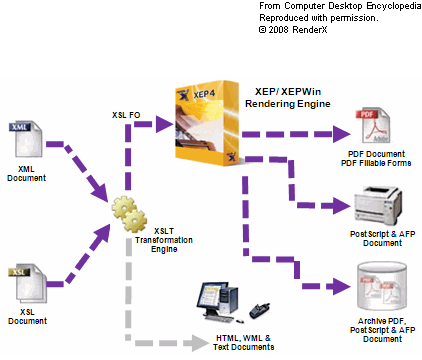 Extensible Stylesheet Language Formatting Objects (XSL-FO) is a powerful and versatile XML-based language that allows you to define the visual presentation of documents. It serves as a formatting resource for transforming XML data into printable or displayable formats, such as PDF, PostScript, HTML, or even direct printing. With XSL-FO, you can control the layout, styling, and pagination of your content, making it an essential tool for creating professional and visually appealing documents.
Extensible Stylesheet Language Formatting Objects (XSL-FO) is a powerful and versatile XML-based language that allows you to define the visual presentation of documents. It serves as a formatting resource for transforming XML data into printable or displayable formats, such as PDF, PostScript, HTML, or even direct printing. With XSL-FO, you can control the layout, styling, and pagination of your content, making it an essential tool for creating professional and visually appealing documents.
XSL-FO follows the principles of separation of content and presentation, which is a fundamental concept in modern web development and document design. It enables you to separate the structure and data of your document from its appearance, making it easier to maintain and update your content without affecting the formatting. This separation is achieved by defining formatting objects that describe how the content should be rendered.
At the core of XSL-FO is the XSLT (Extensible Stylesheet Language Transformations) specification. XSLT allows you to transform XML data into XSL-FO documents by applying stylesheets and templates. These stylesheets define the rules and properties that govern the visual representation of your content. By using XSLT, you can extract the relevant information from your XML data and generate XSL-FO documents that are ready for rendering.
XSL-FO provides a wide range of formatting capabilities to create visually rich documents. It includes support for page layout, such as defining page size, margins, and columns. You can control the placement and alignment of content elements, such as paragraphs, tables, images, and footnotes. XSL-FO also offers typographic features like font selection, text spacing, line breaking, and hyphenation. Furthermore, it allows you to incorporate headers, footers, page numbers, and other dynamic elements into your documents.
One of the significant advantages of XSL-FO is its platform independence. Since XSL-FO is based on XML, it can be processed by various tools and engines on different platforms. There are several open-source and commercial software packages available that support XSL-FO rendering, making it accessible to a wide range of developers and users. XSL-FO’s compatibility with multiple output formats, such as PDF and HTML, allows you to produce documents suitable for different purposes and devices.
While XSL-FO offers extensive formatting capabilities, it does require some learning and expertise to utilize its full potential. Understanding the XSLT transformation process, mastering the XSL-FO vocabulary, and familiarizing yourself with the available properties and options are essential for effective usage. However, once you grasp the fundamentals, XSL-FO becomes a valuable resource for generating complex and visually appealing documents with precise control over their layout and styling.
In conclusion, XSL-FO serves as a formatting resource for transforming XML data into visually presentable documents. With its separation of content and presentation, XSL-FO provides a flexible approach to document design. By defining formatting objects and utilizing XSLT transformations, you can control the layout, styling, and pagination of your content. XSL-FO’s platform independence and compatibility with various output formats make it a versatile choice for creating professional documents. Though it may require some initial effort to master, XSL-FO rewards users with the ability to produce visually rich and highly customizable documents.

